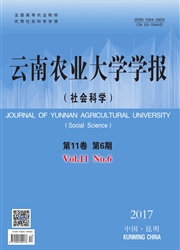

 中文摘要:
中文摘要:
云南永胜涛源乡是保持我国水稻小面积超高产纪录的特殊生态区,采用平板计数法和BIOLOG碳素利用法,研究该地区水稻根际微生物物种和功能多样性。结果表明,高产水稻根际可培养微生物总数接近对照2倍,三大类微生物数量表现为细菌〉放线菌〉真菌,属健康的"细菌型"土壤,水稻高产与自然土层中的微生物关系不大。高产水稻土Shannon均匀度指数(E)和Simpson指数(D)均与对照无显著差异,Shannon多样性指数(H)与对照达到差异显著,微生物物种多样性和均匀度不是高产与非高产区域的主要差别。AWCD值分析表明,高产水稻土群落代谢活性总体强于对照,二者间的差别幅度由大到小表现为分蘖期〉收获期〉苗期〉轮作期,水稻生长越旺盛,与对照间碳源利用能力差别越大。Shannon、Simpson和Mc Intosh 3个多样性指数综合分析表明,高产水稻土根际微生物数量更多,代谢能力更强,微生物群落分布更均匀,多样化程度更高,能够利用的碳源种类更丰富,数量占比较大、种类较集中的常见种并不是形成产量优势的重要因素;分蘖期是高产水稻生长的关键时期,分蘖期根际微生物数量多、种类繁、代谢能力强、代谢类型多是高产水稻旺盛生长和高产形成的关键所在。
 英文摘要:
英文摘要:
Taoyuan, Yunnan Province is a special eco-site which keeps the highest yield records of rice cultivation in small planting areas.Soil microbial species and functional diversity were evaluated using cultivation method and BIOLOG ecoplates. The results showed that the microbial community of the high yield region was more abundant, and the total microbial population was 2 times of the control, furthermore,the areas belonged to the healthy "bacteria" soil, which was showed as bacteriaactinomycetesfungi. Bacteria were the dominant populations in the rhizosphere of high yielding rice field, and the yield formation of rice was not correlated with the depth of soil layers. In order to obtain more species diversity information, Shannon diversity index H, Shannon evenness index E and Simpson index D were analyzed, and the results showed that microbial community diversity and evenness were not the main differences between the high and general yield areas. Then,the functional diversity of soil microbial community was investigated through the average well color development(AWCD)and diversity index analyses. The results of AWCD analysis indicated that the metabolic activity of soil microbial community in high yield paddy soils were stronger than the control. Moreover, the difference range from large to small showed as tillering stage〉harvest period〉seedling period 〉rota-tion period, the stronger the rice growth, the greater the difference between the high yield region and the control. At tillering stage and harvest stage, due to the vigorous plant growth, the root exudates were rich, and the microbial communities of high yield paddy soils showed a strong metabolic activity and strong ability to use carbon sources. The results of Shannon, Simpson and Mc Intosh indices analysis indicated that common microbial species was not a key factor affecting the yield of rice. Tillering stage was a key period for the growth of high yield rice, and many characteristics of this period were the important reasons for high yield f
 同期刊论文项目
同期刊论文项目
 同项目期刊论文
同项目期刊论文
 期刊信息
期刊信息
